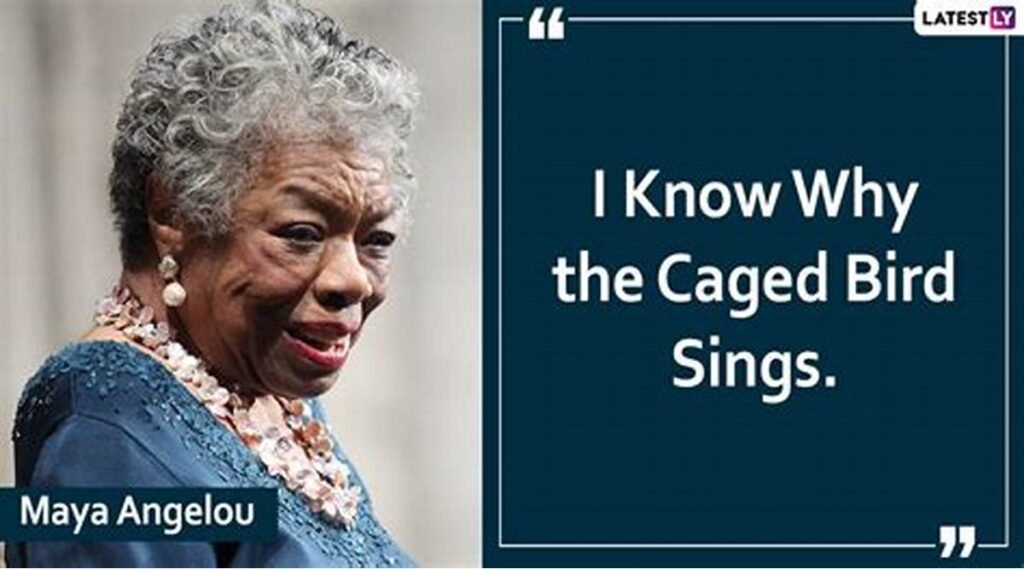Maya Angelou’s “Caged Bird” is one of the most iconic poems in American literature, celebrated for its exploration of freedom, oppression, and the human spirit’s resilience. Angelou, known for her powerful storytelling and advocacy for civil rights, uses this poem to depict the emotional and physical imprisonment of both African Americans and marginalized individuals, while also highlighting the fierce desire for liberation and empowerment. The poem is more than just a piece of literature; it is a statement on the struggle for personal and collective freedom, making it an essential work in the conversation about identity and resistance.
Themes in “Caged Bird”
- Freedom vs. Oppression At the heart of “Caged Bird” lies the powerful theme of freedom juxtaposed with oppression. The poem contrasts the life of a free bird with that of a caged bird. While the free bird soars through the sky without limitations, the caged bird is trapped, longing for liberation. This metaphor powerfully captures the experiences of individuals or groups who are oppressed or confined by societal structures, most notably the African American experience during Angelou’s lifetime, but also anyone who feels restricted by circumstances beyond their control.
- The Desire for Liberation The caged bird’s song is a cry for freedom, symbolizing the deep yearning for liberty that transcends physical confines. Angelou presents the bird’s song as an expression of hope and defiance—a reminder that even in the most confined circumstances, there remains an unbroken spirit, a desire to break free and rise above. The repeated refrain of the bird’s song symbolizes both pain and a call to action for liberation.
- Identity and the Human Spirit The caged bird’s struggle is not only a reflection of physical confinement but also an allegory for the psychological and emotional oppression that many face. The bird’s song represents the human spirit’s refusal to be crushed by adversity. For Angelou, the human identity is inherently strong, and despite facing hardship, individuals can retain their sense of self and continue to strive for freedom, even when it seems unattainable.
- Resistance and Persistence The bird’s song also serves as an act of resistance. Despite its captivity, the bird does not give up on singing. Angelou uses this image to convey the importance of persistence in the face of struggle, underscoring that resistance does not always need to take the form of direct action but can also be found in the quiet, consistent expression of inner strength. The bird’s song is both an act of protest and a beacon of hope.
Literary Devices in “Caged Bird”
- Symbolism Angelou’s use of symbolism is central to the poem. The caged bird itself symbolizes those who are oppressed or denied their rights, while the free bird represents those who are unburdened by societal restrictions. The song of the caged bird becomes a symbol of resistance and hope, echoing the voice of anyone who longs for freedom and equality.
- Metaphor The poem employs the metaphor of the bird to explore the contrast between freedom and oppression. The caged bird, despite being physically confined, is not broken in spirit, as its song symbolizes the power of the human will. The metaphor of the bird is not just about the physical cage but also about the larger societal forces that try to limit human potential.
- Repetition Repetition is a key stylistic device in the poem. The line “The caged bird sings” is repeated multiple times throughout the poem, reinforcing the bird’s persistent desire for freedom. The repetition also gives the poem a rhythm, mimicking the repetitive nature of the struggle for equality and the continuous fight against oppression.
- Imagery Angelou’s vivid imagery paints a stark picture of the contrast between the lives of the free bird and the caged bird. The free bird is depicted as enjoying the wide-open spaces, while the caged bird’s world is small, confined, and constrained. This imagery strengthens the emotional impact of the poem, enabling readers to feel the oppression and yearning of the caged bird.
- Personification The poem personifies the birds, particularly the caged one, by giving them human-like qualities. The caged bird “sings” in the face of adversity, representing the human spirit’s ability to maintain hope even in the most dire of circumstances. This personification allows readers to relate to the birds’ plight on a deeply emotional level.
Structure and Form
Caged Bird is a free verse poem, meaning it does not follow a specific rhyme scheme or meter. This lack of structure mirrors the theme of freedom, as the poem itself is unrestricted by formal rules, allowing Angelou to express the themes of the poem without limitations. The free verse style reflects the emotional intensity and rawness of the message, focusing more on the message of liberation and identity than on formal structure.
The poem’s form is divided into stanzas that alternate between descriptions of the free bird and the caged bird, culminating in the repeated refrain of the caged bird’s song. This structure emphasizes the contrast between the two birds while allowing the emotional climax of the poem to unfold in the repeated song, which symbolizes hope and resistance.
Analysis of Key Lines
- “The free bird leaps / on the back of the wind” In these opening lines, Angelou depicts the free bird as unburdened and wild, able to move freely through the world. The imagery of the “back of the wind” suggests a sense of power and agency, highlighting the contrast between the free bird’s liberty and the confinement of the caged bird.
- “But a bird that stalks / down his narrow cage” These lines describe the caged bird’s confined existence. The metaphor of the “narrow cage” reinforces the idea of limitation, both physically and psychologically. The bird’s “stalking” also suggests a sense of entrapment and frustration, as it cannot escape its small, restricted space.
- “The caged bird sings / with a fearful trill” Here, the bird’s song is described as both beautiful and filled with fear. This line encapsulates the tension between hope and fear, as the bird’s song becomes both an act of resistance and a cry for freedom, while still acknowledging the pain of its imprisonment.
Conclusion: The Enduring Message of “Caged Bird”
Maya Angelou’s “Caged Bird” transcends its specific historical context, becoming a universal symbol of oppression, resistance, and the unbreakable spirit of hope. The poem captures the powerful longing for freedom, emphasizing the human capacity to dream, resist, and persist in the face of adversity. Angelou’s vivid imagery and use of metaphor create a poignant and emotional exploration of identity, oppression, and the universal struggle for liberation. The caged bird’s song is not just a lament; it is a call for change and a declaration of the unyielding power of the human will.

